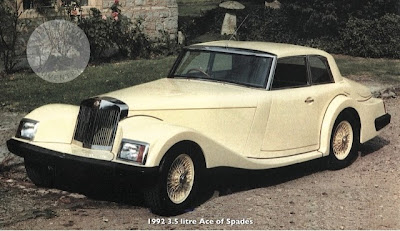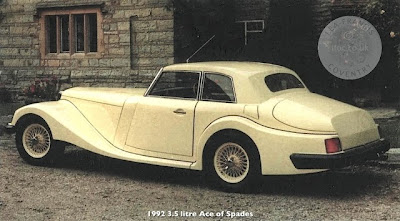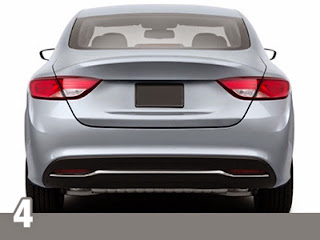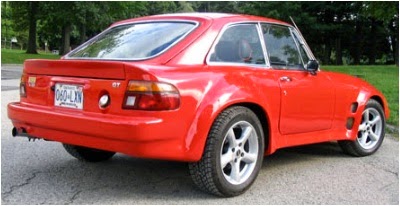Found via eBay, this beauty - believe it or not - is fitted with a custom body kit. Penned by the skilled hands of the world's foremost toddler car designer, it's vaguely reminiscent of a Ferrari Testarossa with the front end of a Cavalier. Randomly applied rectangular bump strips on the front and rear protect roughly 10% of the car from dings. The front end features a RAM Air hood and an innovative 4L gas tank sitting precariously in the grill. Crash test results pending.
The interior features trimless doors for weight savings, and a 6" slab of a leather sofa haphazardly glued to the dash for the occupants safety in the even of a crash.
A blog devoted to RANTS ON AUTOMOTIVE DESIGN, car reviews, and - above all - fugly autos. whether looking for vehicular plagiarism or rides of extreme tastelessness, you've come to the right place.
Tuesday, September 30, 2014
Gh-Gh-Gh-Ghia!
Chrysler and Ghia's show car partnership of the 50's produced some of
the more elegant designs of the 50's. The US automotive world was just
beginning to see these flights of fancy, as previous to Buick's Y-Job
of 1938, no one really made them. However, because the stylists were
new to this unrestrained artwork, the end products were usually extreme
works of automotive fantasy bordering on garish, with lots of chrome,
flares and fins.
The scene in Europe at the time, however, was much different. Independant coachbuilding firms like Bertone, Pinin Farina, Ghia, and Figoni & Falaschi were taking cars ranging from the pedestrian to the extremely expensive and transforming them into works of art, and had been doing so for a while. These firms arguably pushed automotive styling into the future, with a certain elegance and often times a lack of flourish usually absent on American cars of the same period.
Chysler witnessed this first hand when invited by Fiat to Italy to give American insight to aid in their volume manufacturing techniques. Chrysler president K.T. Kellar was inspired, and set to work producting the series of show cars featured in this post.
The outcome was a bunch of remarkable similar concept cars, each refining the lines and design themes of the last. Their signature organic curves, the rise in the shoulderline over the rear wheels, inset headlights and narrower, "egg crate" style grille make for instantly recognizable cars. They were popular enough that they even sold some in production guise (the images included in this post are both production cars).
Built by Carrozzeria Ghia in Italy, many assume that they were designed by Ghia was well, given their restrained European looks. However, they were the product of Virgil Exner, then a fledgling automotive desinger at Chrysler. Somewhat ironically I suppose, as he was resposible for the fantastic fins of the "Forward Look" Chryslers of the late 50's, and nearer the end of his career he was producing some rather strange an ungainly designs that have been featured here before.
Which brings me to the ugly part of the story - this car.
Although I haven't found much info on this car, it appears to be a one off production car from 1954, designed by Virgil Exner in the vein of the rest of the Chrysler Ghia coupes of the period. All the cues mentioned above are in place, except for one noticable difference - the headlights. Where the other cars have single round headlights placed slightly inboard of the fenders, this car has inset quad headlight place so low on the front end they look like an early experiment for fog lights. The featureless expanse of bulging sheet metal above makes the car look ungainly, even larger than it already is, and to be honest a little sad and defeated. What were elegant lines begin to look more like a depressed block of soap.
The sole ugly sibling in a family of supermodels. Must be rough.
The scene in Europe at the time, however, was much different. Independant coachbuilding firms like Bertone, Pinin Farina, Ghia, and Figoni & Falaschi were taking cars ranging from the pedestrian to the extremely expensive and transforming them into works of art, and had been doing so for a while. These firms arguably pushed automotive styling into the future, with a certain elegance and often times a lack of flourish usually absent on American cars of the same period.
| 1954 Chrysler Ghia Special GS-1 |
Chysler witnessed this first hand when invited by Fiat to Italy to give American insight to aid in their volume manufacturing techniques. Chrysler president K.T. Kellar was inspired, and set to work producting the series of show cars featured in this post.
The outcome was a bunch of remarkable similar concept cars, each refining the lines and design themes of the last. Their signature organic curves, the rise in the shoulderline over the rear wheels, inset headlights and narrower, "egg crate" style grille make for instantly recognizable cars. They were popular enough that they even sold some in production guise (the images included in this post are both production cars).
Built by Carrozzeria Ghia in Italy, many assume that they were designed by Ghia was well, given their restrained European looks. However, they were the product of Virgil Exner, then a fledgling automotive desinger at Chrysler. Somewhat ironically I suppose, as he was resposible for the fantastic fins of the "Forward Look" Chryslers of the late 50's, and nearer the end of his career he was producing some rather strange an ungainly designs that have been featured here before.
Which brings me to the ugly part of the story - this car.
 |
| Uh oh - the front is melting. |
Although I haven't found much info on this car, it appears to be a one off production car from 1954, designed by Virgil Exner in the vein of the rest of the Chrysler Ghia coupes of the period. All the cues mentioned above are in place, except for one noticable difference - the headlights. Where the other cars have single round headlights placed slightly inboard of the fenders, this car has inset quad headlight place so low on the front end they look like an early experiment for fog lights. The featureless expanse of bulging sheet metal above makes the car look ungainly, even larger than it already is, and to be honest a little sad and defeated. What were elegant lines begin to look more like a depressed block of soap.
The sole ugly sibling in a family of supermodels. Must be rough.
Sunday, September 28, 2014
Cue the Q
In 2014, Infiniti choose to rename it's entire line of cars and SUVs. A risky move for sure, one that can lead to confusion (just look at what happened to Lincoln). But confusion is an understatement this time around.
Infiniti wants you think of the letter Q when you see an Infiniti. Why Q? I assume it's because of the Q45, which was it's first model - one that strove to be different. And maybe that's what Infiniti wants to be again. But there inlies the problem - they had a car model called the Q45, which was always their halo model. Maybe they want people mistaking even their cheapest car for their halo model?
The 45 in Q45 originally stood for displacement. And this is the next confusing bit - they now want the number just to signify a size of car or SUV. Think Audi or Mazda. Except they'll still use two numbers for some reason. Maybe to look like their old naming structure? I think the reason for this is because engine sizes are decreasing as fuel efficiency is a concern. And with turbos flooding the market, displacement shrinks even more. Having a Q45 one year and a Q35 the next might have some people thinking it's less of a car. You can see this over at BMW and Mercedes, whose model names also used to refer to displacement. Nowhere is this more obvious than in the 3 Series. The E36 328i was a top-of-the-line model with a 2.8L six. Today's 328i uses a 2.0L turbo four. You could call it a 320i, but the designation was typically a lower rung model - it's been the base model 3 Series for a while now, powered by a non-turbo 2.0L four. Borrowed displacement it is then...
Back to Infiniti. The displacement issue has already cropped up in a couple of ways. The first, most obvious one centers around the QX56, which was renamed the QX80. No - it doesn't have an 8.0L V8 now. But now it's joined by the QX50 (previously the EX35/EX37), QX60 (briefly on the market as the JX35), and the QX70 (previously the FX35/FX45). QX50, QX56, and QX60 are all so close when written, but are all drastically different vehicles.
And then there's the Q40 and Q50, which both used to be called the G37. When the last G37 was up for a refresh, it happened just in time for all this Q renaming nonsense. So when the new generation of G37 came to be, it was rechristened the Q50. So what exactly is the Q40? Infiniti dealers were wanting a base model to get more people in the showroom. The Q37/Q50 being their current lowest priced model, Infiniti decided to continue making that last generation Q37 and sell it as a Q40. The car is identical - it just has a new name 10 digits less than the QX50 so it fits in the new naming structure hierarchy.
Oh yeah - and the G37 coupe was renamed the Q60, but unlike the Q50 (and like the Q40), it isn't a redesigned model and was simply renamed, which may or may not mean the coupe may begin to stray farther from it's sedan roots.
So there you have it. Thoroughly confusing. Hopefully it will make more sense with time, at least until they need a model smaller than the inevitable Q10.
Infiniti wants you think of the letter Q when you see an Infiniti. Why Q? I assume it's because of the Q45, which was it's first model - one that strove to be different. And maybe that's what Infiniti wants to be again. But there inlies the problem - they had a car model called the Q45, which was always their halo model. Maybe they want people mistaking even their cheapest car for their halo model?
The 45 in Q45 originally stood for displacement. And this is the next confusing bit - they now want the number just to signify a size of car or SUV. Think Audi or Mazda. Except they'll still use two numbers for some reason. Maybe to look like their old naming structure? I think the reason for this is because engine sizes are decreasing as fuel efficiency is a concern. And with turbos flooding the market, displacement shrinks even more. Having a Q45 one year and a Q35 the next might have some people thinking it's less of a car. You can see this over at BMW and Mercedes, whose model names also used to refer to displacement. Nowhere is this more obvious than in the 3 Series. The E36 328i was a top-of-the-line model with a 2.8L six. Today's 328i uses a 2.0L turbo four. You could call it a 320i, but the designation was typically a lower rung model - it's been the base model 3 Series for a while now, powered by a non-turbo 2.0L four. Borrowed displacement it is then...
 | ||
| Inifiti QX80: New Name, Same Angry Hippo Looks |
Back to Infiniti. The displacement issue has already cropped up in a couple of ways. The first, most obvious one centers around the QX56, which was renamed the QX80. No - it doesn't have an 8.0L V8 now. But now it's joined by the QX50 (previously the EX35/EX37), QX60 (briefly on the market as the JX35), and the QX70 (previously the FX35/FX45). QX50, QX56, and QX60 are all so close when written, but are all drastically different vehicles.
And then there's the Q40 and Q50, which both used to be called the G37. When the last G37 was up for a refresh, it happened just in time for all this Q renaming nonsense. So when the new generation of G37 came to be, it was rechristened the Q50. So what exactly is the Q40? Infiniti dealers were wanting a base model to get more people in the showroom. The Q37/Q50 being their current lowest priced model, Infiniti decided to continue making that last generation Q37 and sell it as a Q40. The car is identical - it just has a new name 10 digits less than the QX50 so it fits in the new naming structure hierarchy.
 |
| G37? Q50? No - Q40! |
Oh yeah - and the G37 coupe was renamed the Q60, but unlike the Q50 (and like the Q40), it isn't a redesigned model and was simply renamed, which may or may not mean the coupe may begin to stray farther from it's sedan roots.
 |
| G37? Q50? Q40? No - Q60! |
So there you have it. Thoroughly confusing. Hopefully it will make more sense with time, at least until they need a model smaller than the inevitable Q10.
Saturday, September 27, 2014
Subarundai
Hyundai's new 2015 Sonata I find to be quite a looker. It's exerior has matured yet it still looks like a Sonata. Gone is the garish chrome waterfall grille, abandoned for a sleeker front end that has some family resemblance to it's older brother, the Genesis.
However, that matured mug also is a bit more generic, looking a bit like other premium brands like Audi and Volvo. And then seeing a the newly revised Subaru Legacy today in the flesh, it hit me that it looks a lot like the new Sonata (although, like the Sonata, it simultaneously looks like an evolution of the last Legacy). It's like the two designs evolved to look like siblings - the Legacy your average sedan, and the Sonata the sporty "4 door coupe" version.
However, that matured mug also is a bit more generic, looking a bit like other premium brands like Audi and Volvo. And then seeing a the newly revised Subaru Legacy today in the flesh, it hit me that it looks a lot like the new Sonata (although, like the Sonata, it simultaneously looks like an evolution of the last Legacy). It's like the two designs evolved to look like siblings - the Legacy your average sedan, and the Sonata the sporty "4 door coupe" version.
Roundel Rondo
This post may be a little confusing for those living in the US, where the Rondo was discontinued in 2010 after slumping sales and the debut of the redesigned 2011 Sportage, which they assumed would fill the void left by it's departure.
However, this wasn't the case in Canada, or most of the rest of the world where the model is known as the Carens. Sales were better in Canada and model carried on, albeit with a revised front end featuring the now standard punched grille.
But enough with the history lesson. What you see here is the next generation Rondo/Carens. It's much more attractive than its dowdy predecessor, and is still missing from the US lineup.
The newfound attractiveness comes at a price though, as it's very close to the BMW 2 Series Active Tourer, which itself is based on the 2012 Concept Active Tourer show car. Yet another recent Kia design that seems to borrow heavily from the BMW school of design Even the rims above are similar. Regardless, it's one of the better looking small people carriers. I even think I like it better than the BMW, which manages to look not a lot like a BMW with its Mini based-bones.
However, this wasn't the case in Canada, or most of the rest of the world where the model is known as the Carens. Sales were better in Canada and model carried on, albeit with a revised front end featuring the now standard punched grille.
But enough with the history lesson. What you see here is the next generation Rondo/Carens. It's much more attractive than its dowdy predecessor, and is still missing from the US lineup.
The newfound attractiveness comes at a price though, as it's very close to the BMW 2 Series Active Tourer, which itself is based on the 2012 Concept Active Tourer show car. Yet another recent Kia design that seems to borrow heavily from the BMW school of design Even the rims above are similar. Regardless, it's one of the better looking small people carriers. I even think I like it better than the BMW, which manages to look not a lot like a BMW with its Mini based-bones.
IS BS
I’m not sure what’s going on over at Lexus. They’ve adopted a style best described as “psychedelic origami predator by Nike”. Their goal was to energize the brand and make it more attractive to a younger generation. Apparently sales have increased, but the polarizing designs are definitely ones you love or absolutely abhor. I’m one of the latter, although the more recent sportier offering like the RC coupe wear the look a little better. Maybe this is one of those cases where the designers eventually evolve the design, with each successive generation learning how to make things more cohesive. Almost like automotive natural selection.
For now I’ll focus on the latest IS, as it’s a good example of what I hate with the current Lexus designs. Other than the limited production LFA, it’s their first model to draw heavily from the extreme and similarly polarizing LF concept cars, with it’s sweeping contours and sharp edges. I should say that I’m not hating on the complete IS package – I actually find most of everything aft of the A-pillars quick sleek and refreshing. Speaking of the LFA, if you look closely at the front of the LFA, you’ll see the spindle shape as well, albeit not in grille form.
Spindle Grille or Mandible Mug?
The Lexus “spindle grille” is where it all started (although to be fair, not on the current IS but on the 2011 Lexus GS). Such a large grille opening can be hard to pull off. Audi has managed to produce some nice looking front ends, but it’s definitely hard to pull off successfully. Although the Lexus grille doesn’t look as “fake” as some, it looks like someone tried to suck the front end off with a vacuum. It also kind of looks like this attractive fellow.
Nike-like
Just as I was getting used to the grille, Lexus threw another design signature into the mix with LED driving light separated into their own units, slashing into the front fascia like metallic Nike swooshes. The IS is notable for being the first Lexus model to adopt this design feature. I guess it’s something we have to get accustomed to, as it’s also appearing on their new NX SUV, which is fugly enough to get a post all it’s own.
Thursday, September 25, 2014
Butt Doubles
I should start out by saying that I don't find the new Chrysler 200C to be an ugly car. It's sleek and has lots of interesting details, especially up front. The only problem is that it looks a bit anonymous, something I've especially noticed when seeing them in public. It tends not to shout at you visually like butch 300C, but blends in the background in a sea of mid-size sedans.
I find this especially true of the rear end, whose treatment looks like any number of near-luxury Japanese cars I'm sure it was trying to ape (as well as many other common mid-size cars who may be trying to do the same).
So I thought I would use this post as a bit of a quiz. Below are images of the butts of few common cars, badging removed. Can you pick you the 200C? The winner will get my unending admiration. Bonus points for anyone who can name them all correctly (bonus points are worth even more unending admiration).
I find this especially true of the rear end, whose treatment looks like any number of near-luxury Japanese cars I'm sure it was trying to ape (as well as many other common mid-size cars who may be trying to do the same).
So I thought I would use this post as a bit of a quiz. Below are images of the butts of few common cars, badging removed. Can you pick you the 200C? The winner will get my unending admiration. Bonus points for anyone who can name them all correctly (bonus points are worth even more unending admiration).
Friday, September 19, 2014
Youabian Puma
“The Puma’s goal is not to be the fastest in the world, but to be the most unique...”
The Los Angeles Auto Show, 2013. Subaru’s new WRX
and the Mercedes AMG Vision Gran Turismo concept dazzle the crowds. But
something giant threatens to steal their thunder, like an angry blue
hippo with a shrunken head. Behold, the 20’
long Youabian Puma. As your eyes wander over the convoluted, bulging
body, you wonder exactly what it is. An aquatic vehicle? An SUV? An abomination that should have been aborted at conception? Yet it’s none
of those things. Well – except that last
one.
“Conceptualized
for those individuals who dare to be different than the ordinary. Those
who go a step beyond achieving and dreaming the best that they can be.”
Technically,
it’s a custom aluminum chassis, a pile of frightening fibreglass, a
Corvette drivetrain and the interior and roof of a Volvo C70. It took
SEVEN YEARS to
develop. And although the name makes some assume it’s some kind of
Chinese automotive cloning disaster, it’s actually from LA – the brainchild of a
plastic surgeon who’s name it bears. A plastic surgeon whose client
base is quickly shrinking since the 2013 LA Auto
Show, no doubt.
But perhaps that most frightening part of all this is the price tag - $1.1M. For what looks like a bloated whale carcass with monster truck wheels and a Volvo C70 stuck in the top. Better start saving.
Topless Metro Escort
Unfortunately
this post is not about a naked, city dwelling prostitute. If you’re
craving some originality for your MG MGB, look no further than
Brooklands Car Components of Kitchener, Ontario. Who wouldn’t want
their classic British sports
car to look like to look like an Escort from the rear and a Geo Metro
from the front?
Ugly Mother-Tucker
The horrifying beast you see here is one man’s attempt at recreating a Tucker Torpedo from a boat-tail Riviera. It’s gained a bit of notoriety on the internet as the late owner’s nephew is trying to unload it on some poor sap via eBay. As of this writing, the listing is closed with the current bid being $16,350, which is probably about $16,000 to much.
Features include: front fenders that turn with the front wheels (a novel feature allowing you to drive in more than straight lines), three headlights, swiveling front seats for ease of exit, “vinyl leather” upholstery, and motorized roof panels that raise for ease of exit (in case you’re built like Robert Wadlow).
Features include: front fenders that turn with the front wheels (a novel feature allowing you to drive in more than straight lines), three headlights, swiveling front seats for ease of exit, “vinyl leather” upholstery, and motorized roof panels that raise for ease of exit (in case you’re built like Robert Wadlow).
Driving Dead
Ah Britian. Land of crumpets, bonnets, al-loo-min-i-um, and defunct car brands. Lea-Francis is one of those brands, and like many of them it started at the turn of the 20th century, only to end midway through. That wasn’t the last the world saw of the brand though, as returned from the grave multiple times in a series of disastrous attempts to cling to the past.
Founded in 1895, they started producing cars in 1903 under license from Singer. In 1919, they started building cars of their own design, but still using mechanical pieces bought from other brands. By the 40s and 50s, they were building sporting cars that looked like a mix of equal parts Allard and MG T-Type Midget. Sales however gradually slowed. The brand needed a fresh reboot to stay afloat.
The reboot came in the form of the 1960 Lea-Francis Lynx. 3 prototypes were made, featuring some rather unique bodywork. Up front a huge, low set round grille dominated the front end. It’s bulbous sides tapered down at the rear, topped with bulky tail fins. If that wasn’t bad enough, the example they brought to the British Motor Show was this hideous dull-pink colour, brightened with gold trim. The public responded by buying absolutely none, and the company shut it's doors for good not long after.

Cue zombie Lea-Francis. Barrie Price – a fan who helped provide service and parts for remaining cars – bought the name and revived the brand by producing the strange looking, coffin shaped “Ace of Spades” in the early 90’s (that bizarre name was taken from the bizarrely named Lea-Francis model of the 1930s). The square-edged neo-classics were powered by Jaguar engines. Only a handful were built.


Yet, like a zombie taking a shotgun to the chest, the brand took the hit in stride and returned again to terrorize the automotive world. Resurrected in 1998 by James Randle in the height of the retro-revival brought on by the New Beetle and Jaguar S-Type, the new car was called the 30/230 and resembled a Z3 with S-Type bits grafted on. One prototype was built before the project was abandoned yet again. Only time will tell if James Randle delivered the head shot Lea-Francis needed to finally rest in peace.

Founded in 1895, they started producing cars in 1903 under license from Singer. In 1919, they started building cars of their own design, but still using mechanical pieces bought from other brands. By the 40s and 50s, they were building sporting cars that looked like a mix of equal parts Allard and MG T-Type Midget. Sales however gradually slowed. The brand needed a fresh reboot to stay afloat.
The reboot came in the form of the 1960 Lea-Francis Lynx. 3 prototypes were made, featuring some rather unique bodywork. Up front a huge, low set round grille dominated the front end. It’s bulbous sides tapered down at the rear, topped with bulky tail fins. If that wasn’t bad enough, the example they brought to the British Motor Show was this hideous dull-pink colour, brightened with gold trim. The public responded by buying absolutely none, and the company shut it's doors for good not long after.

Cue zombie Lea-Francis. Barrie Price – a fan who helped provide service and parts for remaining cars – bought the name and revived the brand by producing the strange looking, coffin shaped “Ace of Spades” in the early 90’s (that bizarre name was taken from the bizarrely named Lea-Francis model of the 1930s). The square-edged neo-classics were powered by Jaguar engines. Only a handful were built.


Yet, like a zombie taking a shotgun to the chest, the brand took the hit in stride and returned again to terrorize the automotive world. Resurrected in 1998 by James Randle in the height of the retro-revival brought on by the New Beetle and Jaguar S-Type, the new car was called the 30/230 and resembled a Z3 with S-Type bits grafted on. One prototype was built before the project was abandoned yet again. Only time will tell if James Randle delivered the head shot Lea-Francis needed to finally rest in peace.

Reboot
Well - it's been two years. That's a lot of time for ugly cars to go by, so I think I'll start posting again. Look for new posts soon!
For now I'll share this local, classy Vaginawagen.
Subscribe to:
Posts (Atom)































